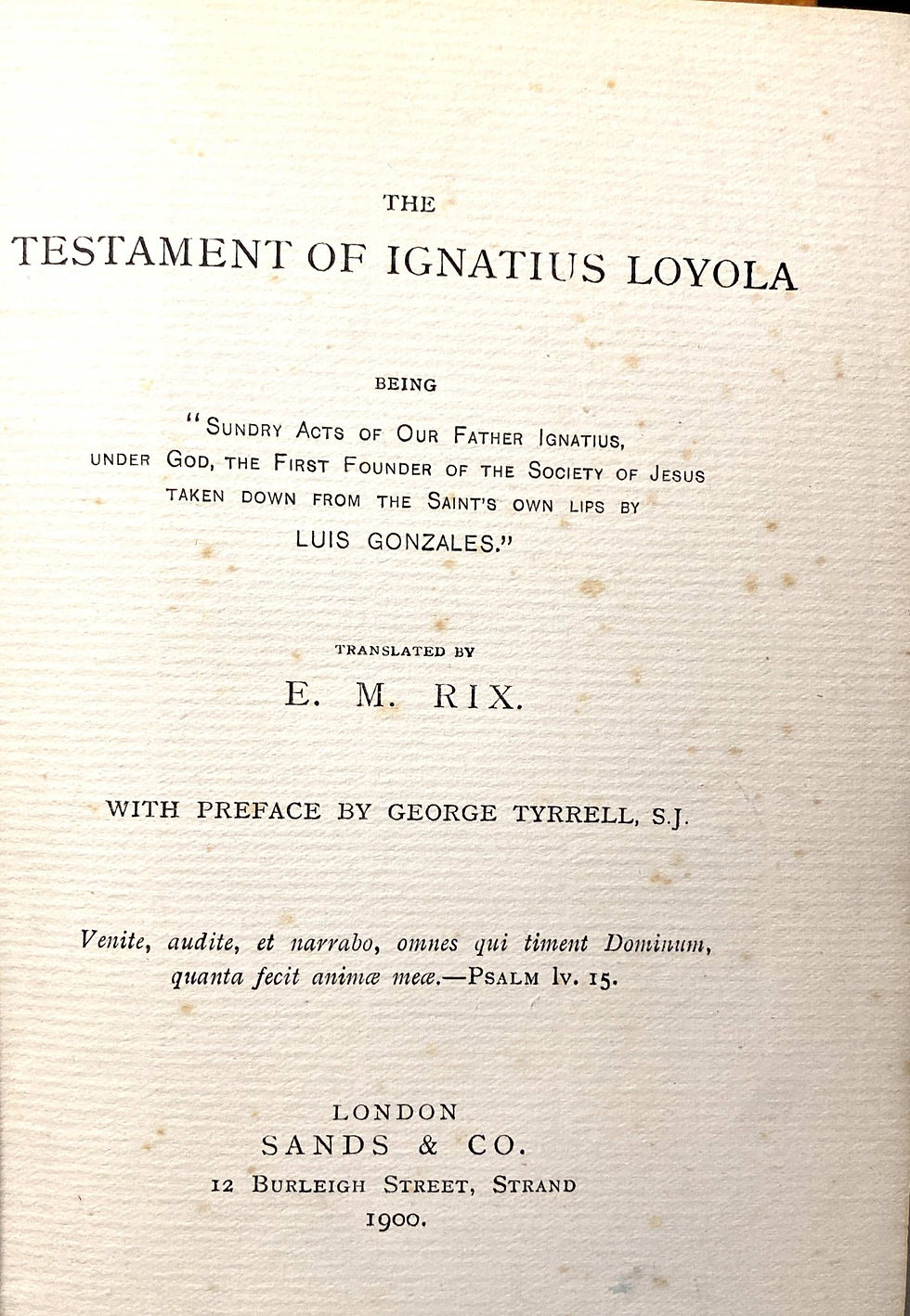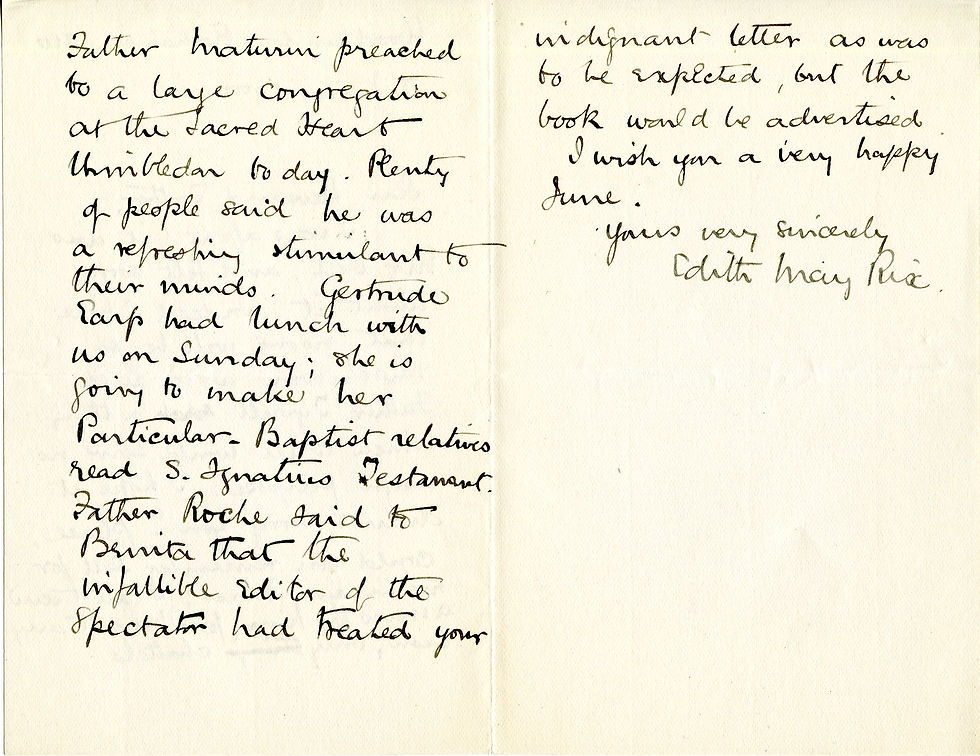The Mystery of E.M. Rix: Uncovering the Translator of The Testament of Ignatius of Loyola
- Francesca Bugliani Knox
- Aug 15, 2025
- 8 min read
For over 125 years, the identity of the translator of The Testament of Ignatius Loyola has remained a mystery. This rare volume, published in London by Sands & Co. in the spring of 1900 and bound in striking blue cloth with gilt lettering, offers few clues. The cover bears only the title and the name “E. M. Rix.” A rebound copy housed in the British Jesuit Archives at Mount Street carries the same cryptic attribution on its spine.
Figure 1 The Testament of Ignatius Loyola 1900 original edition and the rebound copy in the British Jesuit Archives
The title page adds little more: The Testament of Ignatius Loyola, being Sundry Acts of Our Father Ignatius, under God, the First Founder of the Society of Jesus, taken down from the Saint’s own lips by LUIS GONZALES, translated by E.M. Rix. It also notes a preface by George Tyrrell SJ, and an epigraph from Psalm lv [the correct reference is Psalm lxv]: Venite, audite, et narrabo, omnes qui timent [the Vulgate has: timetis] Dominum, quanta fecit animae meae, a fitting summation of the book’s purpose: Ignatius’s own testimony to God’s work in his life.

Who was E. M. Rix? And why do we know nothing about him (or possibly her)? What connection did Rix have to George Tyrrell (1861-1909), who penned not only the introduction dated 31 July 1899, the Feast of St Ignatius, but also the epilogue dated 8 December 1899, the Feast of the Immaculate Conception, along with some of the annotations? And what role did Rix play in the intellectual circle that included Tyrrell’s close friend Herbert Thurston SJ (1856-1939), who provided the appendix with a detailed bibliography and most of the historical notes to the text?
Rix’s translation is significant historically. It was the first English translation of St Ignatius of Loyola’s spiritual autobiography, as dictated to his companion, Luis Gonçalves da Câmara, and indeed the first translation into any modern language. The text used was the only printed version available at the time: the Latin Acta quaedam Patris Ignatii, published in the Acta Sanctorum in 1731. This was itself a Latin rendering, by Anibal de Coudret SJ (1525-1599), of the original manuscript written partly in Spanish, partly in Italian. That original had long been suppressed, its circulation having been halted by the third Superior General of the Society of Jesus, Francis Borgia (1510-1572), and would remain unpublished until the Monumenta Historica Societatis Iesu published it in 1904.
How, then, did Rix come to know this obscure Latin text? How did he or she recognize its spiritual and historical importance and decide to make it accessible to English-speaking readers before the editors of Monumenta did? Might “E. M. Rix” have been a pseudonym for George Tyrrell himself? Determined to uncover the translator’s identity, I began my search by looking online, which led me to the holdings of the British Jesuit Archives and to the collections of the British Library.
One promising lead emerged. In the online records of The Royal Observatory Greenwich, I found a reference to Edith Mary Rix (1866-1918), born in Beccles, Suffolk, the eldest of four children of Frederic Shelly Rix (1836-1933) and Jemima Bostock Bradley (c.1831-1902), and granddaughter of Samuel Wilton Rix (1805-1894), a solicitor, antiquarian, and classicist. Edith boarded at a private school in St James Terrace, Paddington, run by Mary M. Robinson (b. 1835), and entered Newnham College, Cambridge in 1885. She later returned to her former school as a teacher before joining the Royal Observatory as one of its first five ‘lady computers’ on 14 April 1890. She became a member of the British Astronomical Association and, in January 1893, took a post as a cataloguer at the Royal Society. Clearly, she was a highly educated and intelligent young woman. Yet there was no immediate clue in these records to any connection to Roman Catholicism or the Jesuits, making her seem an unlikely candidate for the translator of The Testament, a work tied so closely to Jesuit authorship and oversight. Furthermore she was a woman.
Next, I turned to unpublished correspondence in the British Jesuit Archives, searching for references to the name “Rix.” To my surprise, I found a letter from Tyrrell to Thurston dated 9 August 1899, ten days after Tyrrell had signed the preface. In the letter he wrote: “Miss Rix is at Aynhoe but goes to York on Monday.” Our translator, it seemed, might, then, have been a woman. Then came the breakthrough: two letters from a “Mary Edith Rix” in the manuscript collection of Thurston, dated respectively 5 and 7 June 1900, written from Woodlands, Roehampton. In the letter of 5 June, she expressed some concern for Tyrrell, who had recently relocated from Farm Street to Richmond, Yorkshire. On 7 June, she mentioned mutual acquaintances, including William Roche SJ (1856-1945) and the reception of The Testament: “Gertrude Earp had lunch with us on Sunday; she is going to make her Particular-Baptist relatives read S. Ignatius’ Testament. Father Roche said to Benita that the infallible editor of the Spectator had treated your indignant letter as was to be expected, but the book will be advertised.”

These letters placed Mary Edith Rix squarely within the intellectual and social orbit of Tyrrell, Thurston, and Roche, all of whom were or had been until recently, active at Farm Street. This evidence strongly suggested that the initials “E.M.” on the book stood for “Edith Mary.” But could it be confirmed beyond any doubt that the Edith Mary Rix in Thurston’s correspondence was the same Edith Mary Rix of Beccles?
The answer came from a surprising source. Beyond her academic and professional life, Edith Mary Rix was known for her lifelong friendship with Charles Dodgson, better known as Lewis Carroll, author of Alice’s Adventures in Wonderland. Their connection began in 1885, when Rix submitted a solution to one of Dodgson’s mathematical puzzles in A Tangled Tale. Dodgson encouraged her studies, visited her at the Observatory, and regularly spent time with her and her circle, in which Miss Benita Grenville-Wells and Miss Gertrude Earp featured prominently. These were the very friends mentioned in Edith Mary Rix’s letter to Thurston, definitive proof that the letter writer, the translator, and the astronomer were one and the same.

Dodgson spoke too of Edith’s spiritual journey. In his journal, dated 25 March 1897, he noted: “Heard from my dear old friend Edith Rix that she has just been received into the Church of Rome. It was probably a very wise step to take.” His entry provides the exact date of her reception: 19 March 1897. A few days later, as he recalled on his entry for 28 March, he wrote a heartfelt letter to her about the change in faith. Though the letter has not survived, his journal records Edith’s visit to him in Oxford later that June, where she attended Mass daily at St Aloysius’ church. On one occasion, he accompanied her, describing the procession with reverence: “There was much beauty in the service... carrying the Host, preceded by a number of girls in white, with veils (who had all had their First Communion that morning), strewing flowers.”
Dodgson didn’t record where or by whom Edith was received into the Roman Catholic Church, but armed with the exact date, I tried my luck with the parish conversion register at Farm Street. And there it was: Edith Mary Rix of Beccles was received into the Catholic Church at Farm Street by none other than Fr Roche, the close friend of Tyrrell and Thurston, the two writers (scriptores) at Farm Street involved in the publication of The Testament Ignatius Loyola.

This raises an intriguing question. Was Edith Rix’s role in translating the Acta quaedam her own initiative, or assumed at the request of Tyrrell and Thurston? Was presenting her as the translator, a woman, and a recent convert, meant to shield Tyrrell and Thurston from scrutiny by the Jesuit Curia in Rome or the English Province? Did they hope that the translation would enable Ignatius’s foundational text to reach a broader audience, including non-Catholics, and by so doing recall the Ignatian spiritual roots of the Society of Jesus? Had not Jerome Nadal said to Ignatius, while encouraging him to dictate his spiritual autobiography: “Hoc esset vere fundare Societatem”? If so (i.e. if they had hoped to reach a broader audience), it might have seemed, for the briefest of moments, that their hopes might be realised. On 2 May 1900, the book received glowing praise in Catholic Notes. But the very next day, Richard F. Clarke SJ (1839-1900), a few months before dying, denounced the book to Rome, harshly criticising Tyrrell and condemning his preface. Accusing all the Farm Street scriptores, and the Provincial, John Gerard SJ (1840-1912), of “quasi-Liberalism”, Clarke demanded the withdrawal of The Testament on grounds that Tyrrell’s preface would compromise the Society.

In the aftermath Tyrrell, who was under scrutiny after being reported to Rome for his article “A Perverted Devotion”, burned all his papers on the Spiritual Exercises, a work that might otherwise have become an important contribution to a renewal of Ignatian spirituality within the Society. From the summer of 1900, his position in the Society became increasingly untenable. He was banned from preaching and giving retreats, and in 1906, his dismissal seemed all but inevitable.
The Testament, swiftly withdrawn from circulation, faded into obscurity even within the Society. Its translator, Edith Mary Rix, died in 1918, having spent time in Storrington where Tyrrell also lived. She probably kept in contact with him but grew wary of being associated with modernist ideas. Her translation, once ground breaking as the first and only English rendering of the Latin Acta quaedam, was only mentioned in footnotes and even then, only occasionally. After 1956, as new translations of Ignatius’s spiritual autobiography proliferated and became central to Jesuit and Ignatian formation, her version, unmentioned even in the standard English edition of St Ignatius of Loyola’s Personal Writings edited in 1996 by Philip Endean SJ (1954-2023) and Joseph Munitiz SJ (1931-2022), survived only in a small number of second-hand and library copies while her identity remained unknown— until now.
References
Lewis Carroll, The Letters of Lewis Carroll, ed. Morton N. Cohen, 2 vols, New York, 1979.
Lewis Carroll, Diaries. The Private Journals of Charles Lutwidge Dodgson (Lewis Carroll). The first complete version of the nine surviving volumes with notes and annotations by Edward Wakeling. With an introduction by Roger Lancelyn Green, The Lewis Carroll Society, 1993.
M. D. Petre, Autobiography and Life of George Tyrrell, vol. 2, London, 1912, pp. 80-82.
We are immensely grateful to Francesca Bugliani Knox for sharing her research discoveries with us and our readers. If you would like to make an appointment to view material from the British Jesuit Archives mentioned in this post please contact us.












Comments